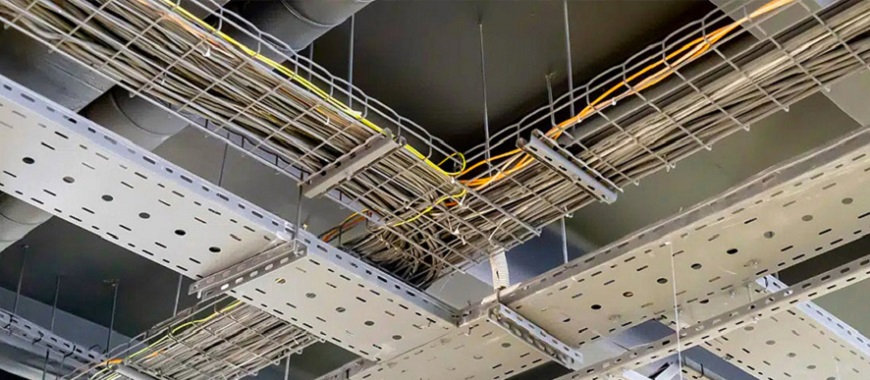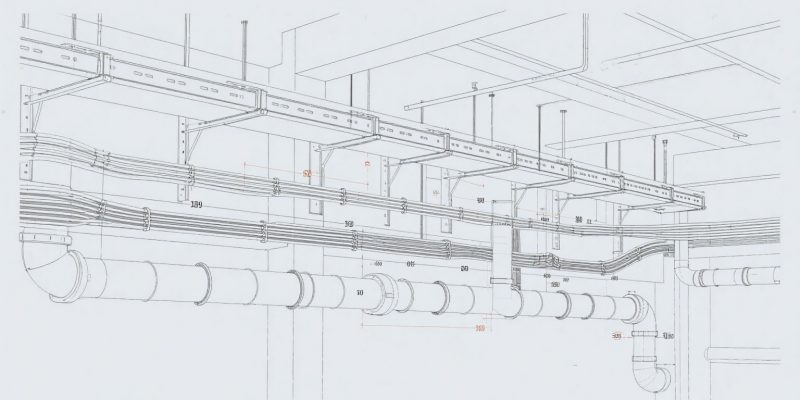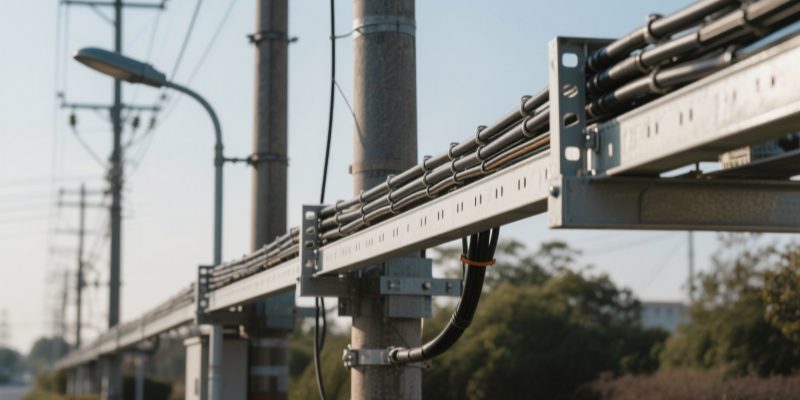
Accurate cable tray load calculation is crucial for the safe and efficient operation of electrical systems. Cable tray load calculation: multiplying cable weight by number of cables and summing individual cable loads lineal foot. By properly calculating the load, engineers can determine the ideal tray size, ensuring it meets the cable tray requirements and has the necessary load-bearing capacity. This helps prevent tray failure, overheating, or electrical malfunctions, which can result from overloading or improper tray selection. Correct load calculations also reduce the risk of system downtime, improve longevity, and minimize safety hazards. In addition, it ensures compliance with local building codes, safety regulations, and industry standards.
To facilitate accurate load calculations, several tools and resources are available. These include downloadable PDF guides, Excel sheets, and online load calculation calculators. Additionally, cara pemasangan cable tray is also an important factor to consider when performing these calculations. These tools enable professionals to quickly and efficiently perform load assessments, ensuring the optimal selection and installation of cable tray systems. By using these resources, engineers can streamline the process, minimize errors, and improve the overall performance and reliability of electrical installations.
What is Cable Tray Load Calculation?
Cable tray load calculation is a critical process in the design and installation of cable tray systems. It involves determining the maximum weight a tray can safely support, ensuring that the tray’s structure can handle the load without causing damage, deformation, or failure. As part of this process, conducting a cable tray risk assessment helps evaluate potential risks associated with improper load handling and system design. Overloading a cable tray can lead to serious issues such as overheating, electrical malfunctions, or even catastrophic failure, which could endanger both the electrical system and personnel. This is why an accurate instrument cable tray loading calculation, along with a comprehensive risk assessment, is essential to guarantee the system’s reliability and longevity.
Key Factors
Cable Type and Weight
The type, insulation, and shielding of cables directly influence their weight. Power cables are generally heavier than control or signal cables, and multi-conductor cables outweigh single-conductor types. In installations using a stacked cable tray, understanding these weight differences is crucial for proper load distribution. Knowing the exact cable type helps engineers accurately determine the load the tray must support, ensuring the system remains safe and effective.
Cable Quantity and Arrangement
The number of cables and their arrangement affect total load and weight distribution. Bundled cables may concentrate weight in certain areas, while individual layouts distribute it more evenly. Engineers must consider these factors to maintain balance, avoid overloading specific tray sections, and ensure even support throughout the installation.
Tray Span and Support Intervals
The distance between tray supports is crucial for preventing sagging. Longer spans require stronger materials or more supports to bear the weight evenly. Properly determining tray span and support intervals helps maintain structural integrity, ensuring that the system remains stable under operational loads without compromising cable safety.
Safety Factors
Safety factors account for unexpected loads from temperature changes, vibrations, or dynamic forces. Commonly ranging from 1.5 to 2.0, these factors ensure the tray can handle more than the calculated load. In any cable tray use, incorporating safety factors enhances reliability, reduces failure risks, and prepares the system for adverse conditions.
Compliance with Standards
Accurate load calculations ensure compliance with NEC, IEC, and other safety standards. These regulations set limits on tray use, cable fill ratios, and protective measures. Adhering to them helps prevent accidents, improves system longevity, and minimizes costly downtime or repairs due to improper tray loading or design.
PDF Guides and Calculation Forms
PDF guides and calculation forms offer standard formulas, examples, and procedures for determining cable tray load capacity. They serve as reliable reference tools for engineers, ensuring consistent and accurate results. These resources streamline the calculation process while maintaining adherence to industry standards and best practices.
Excel Sheets and Calculators
Pre-designed Excel sheets and online calculators automate load calculations, allowing quick adjustments to parameters like tray size, cable count, and span. This saves time, reduces errors, and provides instant feedback for different scenarios, enabling engineers to efficiently test design variations and make informed decisions.
Manufacturer Load Tables
Cable tray manufacturers often provide load tables detailing the capacity of various tray types and materials. These tables help engineers match project requirements with the right tray, ensuring optimal strength, safety, and durability. Using manufacturer data reduces guesswork and increases accuracy in load selection.

Simplify Projects with This B-Line Cable Tray Installation Guide
Cable Tray Load Calculation Formula
The Basic Formula for Load Calculation
The cable tray load calculation formula is typically based on the weight of the cables and the structural characteristics of the tray. A simplified formula is: Total Load (lbs)=Cable Weight per Foot×Total Cable Length\text{Total Load (lbs)} = \text{Cable Weight per Foot} \times \text{Total Cable Length}
This formula calculates the total weight of the cables to be supported. Additional considerations, such as tray span, material, and safety factors, must be incorporated into the design to ensure that the tray can bear the total load without excessive stress.
Steel Cable Tray Load Calculation
- Material Strength & Use Case:Steel trays are the most robust and durable, ideal for heavy loads in industrial settings. They are stronger and more rigid than aluminum or fiberglass, allowing longer spans without sagging.
- Key Load Calculation Factors:Cable weight includes type, size, and insulation of cables. Distance between supports affects load capacity, and the type of steel (galvanized, stainless) influences both strength and corrosion resistance.
- Tray Self-Weight Considerations:Steel is heavier than aluminum or fiberglass, and its own weight must be factored into the total load, especially over long spans.
- Dynamic Load Factors:Vibrations, temperature changes, and other environmental forces must be considered. While steel resists vibrations well, prolonged stress can still cause fatigue.
- Environmental and Safety Factors:Safety factors should be included to handle unexpected loads. Galvanized steel offers corrosion resistance, while stainless steel provides higher mechanical durability.
- Importance of Accurate Calculation:Accurate calculations ensure the tray is properly sized for cable load and environmental demands, preventing deflection, failure, and costly system downtime.
How to Calculate Cable Tray Loading: A Ultimate Step-by-Step Guide
Step 1: List All Cables and Their Specifications
Start by identifying every cable that will be installed in the tray. For each one, note:
- Cable type (e.g., power, control, data)
- Size and insulation type
- Manufacturer’s specified weight per meter (or per foot)
Also, count how many runs of each type you’ll have. This list will form the basis of all your load calculations.
Step 2: Calculate Cable Weight per Meter
For each cable type, multiply the weight per meter by the number of runs. This gives the total weight for that cable type per meter. Then, sum up all the results to get the total cable weight per meter (Wc).
Formula:
Wc = Σ(weight per meter × quantity of runs)
Step 3: Include the Tray’s Own Weight
Cable trays have their own weight, known as self-weight. Find this in the manufacturer’s data sheet, usually given in kg/m or N/m. Add this to the cable weight per meter to get the total uniform load per meter (Wu).
Formula:
Wu = Wc + Wt (where Wt is tray self-weight)
Step 4: Determine Span and Support Spacing
The span is the distance between tray supports. Longer spans require stronger trays or additional supports. Measure the distance between supports to use in your load calculations.
Step 5: Convert to Load per Span
Multiply the total uniform load per meter (Wu) by the span length to get the total load on each span. If you have additional concentrated loads such as junction boxes, call these point loads (Pp) and add them separately.
Formula:
Pu = Wu × span length
Step 6: Apply a Safety Factor
To account for unexpected stresses—like temperature expansion, vibration, or future modifications—apply a safety factor (SF), typically between 1.5 and 2.0.
Formula:
Pd = (Pu + Pp) × SF
Step 7: Compare with Manufacturer Ratings
Check the calculated design load (Pd) against the manufacturer’s load rating for that tray, at your exact span length. If your design load exceeds the rating, you may need to reduce the span or choose a stronger tray.
Step 8: Check Deflection Limits
Even if the load rating is fine, excessive deflection can damage cables. Refer to standards or manufacturer guidelines (often span/200 or span/240) to confirm the deflection is within acceptable limits.
Step 9: Consider Environmental Factors and Cable Fill
Think about real-world conditions:
- Temperature extremes
- Outdoor exposure and corrosion
- Vibration or mechanical shock
Also, ensure the tray is not overfilled—allow space for cooling and airflow.
Step 10: Allow for Future Expansion
Many installations grow over time. Add an extra margin (commonly 20%) to your cable load calculations to avoid replacing the tray later.
Example Calculation
Let’s assume we need to calculate the load for a steel cable tray supporting 500 feet of cable weighing 10 pounds per foot. The total cable load would be: Total Load=10 lbs/ft×500 ft=5,000 lbs\text{Total Load} = 10 \, \text{lbs/ft} \times 500 \, \text{ft} = 5,000 \, \text{lbs}
Then, the tray must be sized and supported according to this load, ensuring it can accommodate this weight, considering tray span, material, and safety factors.

Tools for Cable Tray Load Calculation
Cable Tray Load Calculation PDF
For professionals involved in cable tray installations, Cable Tray Load Calculation PDFs are valuable resources that offer comprehensive guidance and reference materials. These PDF guides are designed to provide in-depth explanations of the various factors that influence the load calculation process. They typically cover the formula for calculating cable tray loads, including key considerations like cable weight, tray span, support spacing, and safety factors. Many PDF guides also feature real-world examples to help engineers understand how to apply the calculations in different scenarios. Furthermore, PDF guides often include detailed information about local codes and regulations such as the National Electrical Code (NEC) and IEC standards, ensuring that the installation meets compliance requirements. Whether for initial planning, troubleshooting, or verification during the installation process, these guides are indispensable tools for ensuring safe and accurate cable tray loading calculations.
Cable Tray Sizing Calculation Excel Sheet
For those looking for a more automated approach to cable tray load calculations, an Excel sheet can greatly streamline the process. Cable tray sizing calculation Excel sheets are pre-formatted with built-in formulas that allow users to quickly input specific cable and tray parameters, such as cable type, number of cables, tray span length, and safety factors. By simply entering the relevant data, the sheet automatically calculates the total load the tray needs to support, making the process much more efficient. Additionally, Excel sheets typically include pre-set fields for common cable types, tray materials, and safety factors, reducing the chances of manual errors and saving time. These Excel sheets are particularly helpful in environments where quick modifications may be required, such as adjusting for additional cables or changing environmental factors. Ultimately, they offer an easy, reliable way to perform cable tray load calculations with minimal effort.
Cable Tray Load Calculation Calculator
Cable tray load calculation calculators are digital tools designed to simplify and accelerate the load calculation process. These online calculators are accessible via any web-enabled device, making them convenient for engineers and contractors working on-site or in the office. Users can input all the relevant information—such as cable type, cable quantity, span length, tray material, and environmental factors—and the calculator will instantly determine the required tray size, material specifications, and even safety margin. Many cable tray calculators are designed to adhere to local codes and industry standards, ensuring compliance throughout the process. These tools are incredibly beneficial because they eliminate the risk of human error, offering precise and consistent calculations every time. Cable tray load calculation calculators are also customizable to suit specific project requirements, such as adjusting for dynamic loads or incorporating unique environmental considerations like temperature variations or vibrations in industrial settings. For professionals seeking quick and reliable results, online calculators are an excellent option for performing load calculation for cable trays.
How to Calculate Area of Cable Tray Accurately
Common Mistakes in Cable Tray Load Calculation
Accurate cable tray load calculation is essential for safety and efficiency. Small mistakes can cause damage, waste, or costly repairs. Knowing the common errors helps you design a tray system that performs well now and in the future.
Overloading and Underloading
Overloading a cable tray can cause warping, bending, or collapse, creating safety hazards and costly repairs. Excess weight increases heat buildup, damaging insulation and raising fire risk. Underloading seems harmless but wastes space, money, and labor, and often fails practical fill expectations. Right sizing matters. Always check the Cable Tray Capacity, use accurate cable weights, confirm support span, include tray self-weight, and apply an appropriate safety factor so the final selection safely carries today’s load.
Ignoring Environmental Factors
Environmental conditions strongly influence tray capacity and lifespan. Heat, humidity, chemicals can reduce material strength or accelerate corrosion. Outdoor sites, coastal plants, and washdown areas demand material selection and coatings. Choose stainless steel, aluminum, or galvanized finishes where appropriate, and verify coating thickness. Include temperature derating, expansion, and corrosion allowances. Document the environment in calculations so the chosen tray resists degradation and supports cables throughout the installation’s expected service life.
Neglecting Future Expansion
Designing only for today’s load often triggers premature replacement when systems expand. Trays without spare capacity cause costly shutdowns, rework, and supports. Build headroom by reserving physical fill space and including a growth allowance in calculations. Many projects use a 20% load margin, but validate against roadmaps. Keep span, support strength, and deflection within limits after growth. Document assumptions so stakeholders understand capacity and plan additions without compromising safety overall.

How Accurate Cable Tray Measurement Ensures System Efficiency
FAQs about Cable Tray Load Calculation
Calculating the load on a cable tray is a critical part of ensuring the tray’s safety and functionality. The general approach involves determining the total weight of the cables it will support and ensuring the tray can handle that weight. Here’s how to calculate the cable tray load:
Step 1: Determine Cable Weight: The first step is to find the weight of the cables per unit length. This information is typically provided by the cable manufacturer and is usually given in pounds per foot or kilograms per meter.
Step 2: Calculate Total Cable Weight: Multiply the cable weight per unit length by the total length of cable that will be installed in the tray.
Step 3: Account for Tray Span and Support Spacing: The span between supports and the type of material used for the tray (e.g., steel, aluminum) will affect its load-bearing capacity. Longer spans may require additional supports to distribute the load evenly.
Step 4: Apply Safety Factors: Safety factors, usually between 1.5 to 2.0, should be applied to account for potential unforeseen conditions (e.g., temperature variations, vibrations). This ensures that the cable tray will remain reliable under extreme or fluctuating conditions.
By following these steps, you can ensure that the cable tray is properly sized to handle the expected load and meet safety standards.
The amount of weight a cable tray can hold depends on several factors, including its size, material, span, and the type of cables it is designed to support. Generally, cable trays are designed to carry substantial loads, but the exact weight capacity varies.
Here are the key factors that influence the load-bearing capacity of a cable tray:
Material: Cable trays made from stronger materials, such as steel, typically have a higher weight capacity than those made from lighter materials like aluminum or fiberglass.
Size: The tray’s width and depth play a significant role in determining how much weight it can support. Larger trays can accommodate more cables and heavier loads.
Span: The distance between supports (tray span) directly impacts the tray’s ability to handle weight. Longer spans generally reduce load capacity, and additional supports may be required to prevent sagging or deformation.
Cable Type and Quantity: The type of cables (e.g., power, control, or fiber optic cables) and the number of cables in the tray also affect the total weight. Larger, thicker cables will weigh more, and the overall cable load will need to be accounted for when determining the tray’s capacity.
To determine how much weight a cable tray can hold, you should always refer to the manufacturer’s specifications, which typically include weight load tables and guidelines based on the specific tray material and design. These can be used alongside the results of your cable tray load calculation to select the right tray for your project.
Calculating the cable tray fill is crucial for ensuring that the tray is not overloaded and that there is adequate space for airflow and cooling. Overfilling a cable tray can lead to overheating, while underfilling can result in wasted space. Here’s how to calculate cable tray fill:
Step 1: Determine Tray Cross-Sectional Area: First, calculate the tray’s total internal cross-sectional area. This is typically done by multiplying the tray’s width and depth (Width × Depth). This gives you the area available for cable placement.
Step 2: Calculate Cable Cross-Sectional Area: Next, you need to calculate the total cross-sectional area of all cables to be placed in the tray. This is typically done by summing up the individual areas of each cable, which are usually calculated based on the cable’s diameter or radius.
Step 3: Calculate the Fill Ratio: The fill ratio is the ratio of the total cable cross-sectional area to the tray’s total cross-sectional area. The formula is:
Fill Ratio
=
Total Cable Cross-sectional Area
Tray Cross-sectional Area
\text{Fill Ratio} = \frac{\text{Total Cable Cross-sectional Area}}{\text{Tray Cross-sectional Area}}Fill Ratio=Tray Cross-sectional AreaTotal Cable Cross-sectional AreaAccording to the NEC (National Electrical Code), the fill ratio should not exceed 50% for ventilated trays when using control or signal wiring.
Step 4: Ensure Compliance: Always ensure the tray is not filled beyond the recommended fill ratio to prevent issues such as poor airflow, overheating, and excessive strain on the tray.
By performing this calculation, you can ensure that the cable tray meets safety requirements and provides adequate space for proper cable installation and heat dissipation.
The National Electrical Code (NEC) provides specific regulations for the installation, sizing, and load calculation of cable trays. These regulations ensure that electrical installations are safe, efficient, and compliant with national standards. Here are the key sections of the NEC related to cable trays:
Article 392: This section specifically covers cable tray systems. It outlines requirements for installation, cable types, tray sizing, and safety standards.
NEC 392.9: This section addresses the cable tray fill ratio. It stipulates that when using control or signal cables, the total cross-sectional area of the cables should not exceed 50% of the tray’s cross-sectional area. This ensures proper ventilation and prevents overcrowding, which could lead to overheating.
NEC 392.10: This section outlines specific size requirements for the cable tray. It states that the smallest single conductor allowed in a cable tray system is 1/0 AWG. It also specifies maximum allowable rung spacing for certain cable types, like 1/0 AWG to 4/0 AWG conductors.
NEC 392.30: This article provides guidelines on securing and supporting cables within the tray. It includes requirements for cable tie usage, support spacing, and methods of securing cables to prevent movement or damage.
The NEC is an essential resource for professionals designing and installing cable trays. Following these regulations ensures that the system will be safe, effective, and compliant with industry standards. For more detailed guidelines, always refer to the full text of NEC Article 392 when planning your cable tray system installation.

As the editor of GangLong Fiberglass, I have years of experience and in-depth research, focusing on cable tray products, fiberglass solutions, and grille systems. I incorporate years of industry insights and practical experience into every content, committed to promoting the progress of the industry. At GangLong Fiberglass, my commitment is reflected in every product, from innovative cable trays to durable fiberglass solutions and sturdy grille systems. As an authoritative voice in the industry, my goal is to provide valuable information to professionals and businesses and promote forward-looking solutions.


